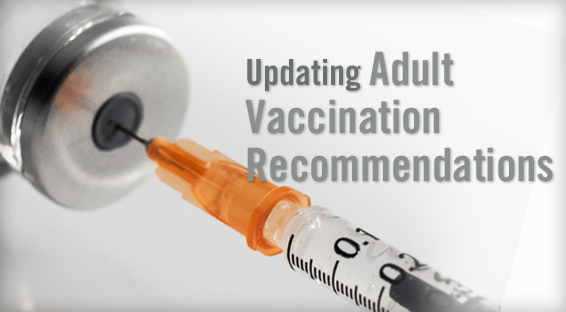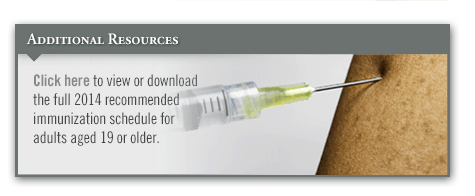Research has shown that current vaccination rates for adults are low. “There are 14 different infectious agents for which vaccines are recommended for adults, but vaccination rates are low for a number of reasons,” says Carolyn B. Bridges, MD. “There is limited public awareness about the need for vaccines for adults besides influenza. Also, patients rely on recommendations about vaccines from their providers, but many providers don’t routinely assess vaccination status and follow with recommendations for the vaccines their patients need.”
Each year, the Advisory Committee on Immunization Practices (ACIP) reviews and updates its recommended immunization schedule for adults aged 19 and older. Each February, the schedule is updated on the CDC website (www.cdc.gov/vaccines). The schedule provides a brief summary of ACIP recommendations using figures and footnotes to describe which patients are recommended to receive each vaccine and a table that describes the primary contraindications and precautions for each vaccine.
Strategies for Improvement
A number of strategies can help incorporate adult vaccinations into clinical practice, including systems changes so that vaccines are routinely assessed and offered. Other strategies include using reminders for healthcare providers (HCPs), such as prompts in electronic health records, using protocols or standing orders for office staff, and sending reminders to patients about needed vaccines. According to Dr. Bridges, one of the most important elements in improving vaccination rates is making sure patients hear from their provider about which vaccines they need.
The CDC has partnered with many organizations to update the Standards for Adult Immunization Practice. The standards are a call to action for providers to:
– Assess vaccination needs among patients in every clinical encounter.
– Recommend needed vaccines.
– Offer vaccinations or refer patients to other providers if vaccines are not offered.
– Document which vaccines patients have received.
“Many adults consult more than one provider,” says Dr. Bridges, “meaning that physicians may mistakenly believe that another HCP is addressing vaccination needs. Documenting vaccinations can help ensure that a complete vaccine history is available to all HCPs.”
Getting Proactive
Resources for implementing vaccination services are available from the CDC and other professional healthcare organizations. HCPs can also review the Community Guide (www.thecommunityguide.org) for more information on proven methods to increase vaccination rates. “These resources are helpful,” Dr. Bridges says, “but a recommendation by HCPs for needed vaccines is one of the strongest predictors of patients actually getting recommended vaccinations.”




 TimH
TimH